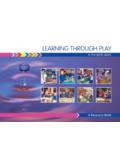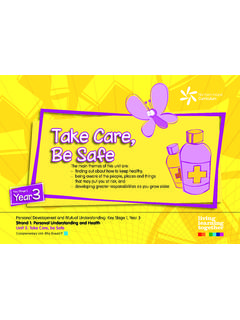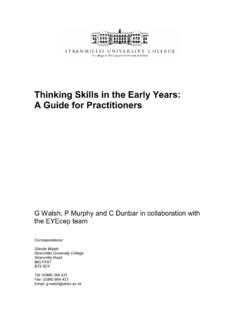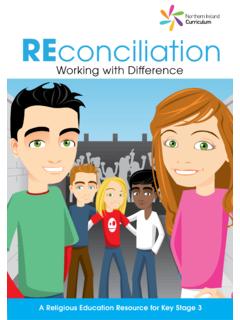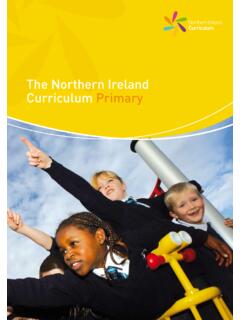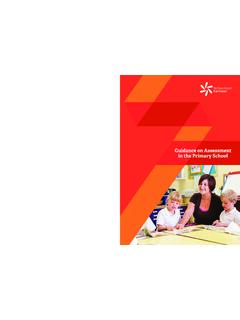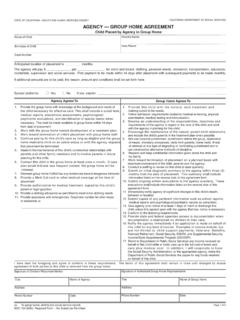Transcription of (PDF) Active Learning and Teaching Methods for Key Stage 3
1 CONTENTSA ctive Learning and Teaching Methods Rationale 1 Section 1 - How to get the most out of using this resource 2 Section 2 Toolkit 7 Art Spiral7 Back-to-back8 CAF (Consider AllFactors)9 Card Ranking11 Carousel12 Clustering13 Collage14 Conscience Alley16 Consequence Wheel17 Constructing Walls18 Creative Matrix19 Dartboard Evaluation21 Diamond Ranking22 Dot Voting23 Drama Techniques24 Each One Teach One25 Fact or Opinion26 Fishbone Strategy27 Fist-to-Five28 Five Questions29 Freeze Frame30 Giant Steps31 Graffi ti Board33 Hassle Lines34 Hot Air Balloon35 Hot Seating 36 Ideas Funnel38 Jeopardy40 Jigsaw41 Just a Minute43 KWL (Know Want toKnow Learned)44 Lifelines45 Memory Game46 Mind Maps48 Mind Movies50 Mysteries51No Easy Answers Board52 Odd One Out53 Opinion Finders54 OPV (Other People sViews)55 People Bingo56 PMI (Plus Minus Interesting) 57 Post-It Collection58 Priority Pyramid59 Revolving Circle61 Simulation62 Snowballing63 Spectrum Debate64 Stick Debate65 SWOT (Strengths,Weaknesses,Opportunities, Threats) 66 Tableau 67 Taboo 68 Talking Heads 69 Think, Pair and Share70 Thumb Tool 71 Traffi c Lights72 Two Stars and a Wish 73 Using Photographs74 Walking Debates 75 When the Wind Blows77 Word Games 78 Zone of Relevance79 AcknowledgementsThe Partnership Management Board would like to thank the many people who contributed to the development and production of the contents of this include colleagues from:Council for the Curriculum, Examinations and Assessment (CCEA)Council for Catholic Maintained Schools (CCMS)The Education and Library BoardsRegional Training Unit (RTU)Classroom 2000 (C2K)The Partnership Management Board would also like to thank all the schools who so generously allowed us to take photographs.
2 Their participation celebrates pupils enjoying Learning . Their involvement makes the materials Learning and Teaching Methods1 Active Learning andTeaching Methods RationaleThe Revised Curriculum aims to empower our young people to develop their potential as individuals and to make informed and responsible decisions for living and working in the 21st society today needs young people who are fl exible, creative, and proactive young people who can solve problems, make decisions, think critically, communicate ideas effectively and work effi ciently within teams and groups. The knowing of knowledge is no longer enough to succeed in the increasingly complex, fl uid, and rapidly evolving world in which we live. In order to optimise life-long Learning and potential success it is now widely accepted that young people need to have opportunities to develop personal capabilities and effective thinking skills as part of their well-rounded skills are an integral part of the Revised Curriculum for Northern Ireland.
3 Increased fl exibility in the curriculum in terms of content and time will offer teachers the opportunity to develop their pupils skills and capabilities concurrently with knowledge and understanding. It is hoped that this approach will actively engage students in their Learning , making the Learning a more relevant, enjoyable and motivational experience. Additionally, teachers will have opportunities to further develop their own skills as creative curriculum following collection is not intended to be a defi nitive resource, but one which provides practical advice to teachers on a varied range of Methods which they may wish to integrate into their daily Learning and Teaching activities. It is hoped that teachers will fi nd it a helpful tool in planning and creating a stimulating, enriching, challenging and focused environment for both their pupils and Stage 3 How to get the most out of using the resourceIt is hoped that Active Learning and Teaching Methods will be dipped into and referred to regularly rather than simply read and shelved, so as to provide you with innovative ideas and strategies to integrate into your Teaching .
4 [Section 1]Getting started a checklist of things to think aboutBelow are some key issues and questions that you may fi nd helpful to consider whilst planning future Learning MotivationFor many teachers there is always more to do and they are always striving to fi nd ways of doing it better the area of effective Learning and Teaching is certainly no exception. It is important that you take the time to ask yourself:Where are you now in terms of your Learning and Teaching practice?What is your motivation behind integrating Active Learning and Teaching Methods into your existing classroom practice?How can you build on your existing practice?What do you hope to achieve? Pupil MotivationBy using Active Learning methodologies it is hoped that pupils will not only come to a deeper understanding of the issues involved, but also that their motivation and enthusiasm will be heightened. You may wish to think about the following points in order to increase pupils motivation:Is the activity age-appropriate?
5 Are pupils completely aware of the aims and objectives?Are there opportunities for pupils themselves to facilitate the activity?Will everybody have an equal chance to participate in the activity?Is there enough variety? Active Learning and Teaching Methods3 Classroom DynamicsEvery pupil and teacher brings with them into the classroom a diversity of skills, experiences, needs and expectations. It is factors such as these which will play a large part in shaping the dynamics within the classroom. It is important that you refl ect on the dynamics of your class. Some questions to think about: How well does the class know one another or is it a new class coming together?Have you ever taught the class before?Are there any specifi c needs/circumstances of individual pupils that you need to take into consideration?What is the profi le of the class size, single sex, mixed ability etc?Are there any specifi c needs to be taken into account in order to aid inclusivity?
6 PreparednessMany teachers and pupils will be at different stages of experience, confi dence and skill development in relation to Active methodologies. This needs to be factored into the planning of questions to think about: Have the group engaged in this type of Learning before?Have you employed Active Learning strategies before in your Teaching ? if yes how confi dent do you feel?How do you see your role changing?How comfortable do you feel/think you will feel in this type of classroom environment? PracticalitiesClassroom surroundings infl uence how teachers and pupils feel and how they act. The classroom environment must be supportive of Active Learning and Teaching . Questions to think about:What is the allocated timetable time for your classes?Are your classroom surroundings conducive to Active Learning how much space is in your classroom, is there display space, what are the seating arrangements, where is your desk positioned etc?How much preparation time is available?
7 4 Key Stage 3 Teacher-centred classroom Learner-centred classroomProduct-centred learningProcess-centred learningTeacher as a transmitter of knowledge Teacher as an organiser of knowledgeTeacher as a doer for childrenTeachers as an enabler , facilitatingpupils in their Learning Subject-specifi c focus Holistic Learning focusFrom:To:These changes in the role of the teacher will inevitably result in transforming the role of pupils in the :To:From To grid showing shift in the role played by pupils in an Active classroom environmentFrom To grid showing shift in the role of the teacher in creating an Active classroom environmentBeing passive recipients of knowledge Active and participatory learnersFocus on answering questionsAsking questionsBeing spoon fed Taking responsibility for their own Learning - refl ective learnersCompeting with one anotherCollaborating in their learningWanting to have their own say Actively listening to opinions of others Learners of individual subjectsConnecting their learningThe Role of the TeacherThe Active and participatory classroom has implications for the role of the teacher.
8 There is a shift from a teacher-centred model to a learner-centred approach to Learning and Teaching . There is also a shift from product-driven Learning to process-driven. These changes encourage teachers to refl ect not only on the key principles of Learning and Teaching but also on their role in the process. Active Learning and Teaching Methods5 The Teacher as FacilitatorIn an Active classroom environment the role of a teacher is often that of a facilitator, supporting pupils as they learn and develop skills in, for example, assessing evidence, negotiation, making informed decisions, solving problems, working independently and working with others. Pupil participation and involvement in their Learning is it is appropriate for the facilitator to take on a particular role/function in an attempt to enhance the Learning within the class or to challenge their thinking in a new way. Some of these possible roles include:Neutral facilitator: The facilitator enables the group to explore a range of different viewpoints without stating their own s advocate: The facilitator deliberately adopts an opposite stance to confront people, irrespective of their own views.
9 This method is slightly tongue-in-cheek .Declared interests: The facilitator declares their own position so that the group knows their : The facilitator supports the views of a particular sub-group or individual (usually a minority) within a cial view: The facilitator informs the group of the offi cial position on certain issues offi cial organisations, the law : The facilitator, through questioning, challenges the views being expressed and encourages the pupils to justify their : The facilitator brings up an argument, viewpoint and information which they know will provoke the class, and which they do not necessarily believe, but because they are authentic beliefs of other individuals or groups, they present them : The facilitator may become a particular person or caricature (for example a church leader or a politician), putting across their arguments and position to the above facilitation roles have their advantages and disadvantages and it is important to weigh these up in planning your lessons.
10 Questions to think about may include:How will I feel about taking on these roles?Can I think of areas in my existing practice to which some of these roles may be applied?Do I sometimes take on some of these roles unconsciously?Are there any specifi c needs in my class to be taken into account?What strategies can I use to deal with diffi cult and challenging issues that may be raised?Am I clear as to what my Learning intentions and outcomes are for the lesson etc? 6 Key Stage 3 ROLE OF FACILITATORN eutralFacilitatorROLE OF FACILITATORD evil sAdvocateIn-roleChallengerDeclaredIntere stsProvocateurOffi cial ViewAllyActive Learning and Teaching Methods7[SECTION 2: TOOLKIT]ART SPIRALS killsBeing CreativeThinking, Decision-MakingWhat is it?This activity allows pupils to personally refl ect and communicate their thoughts, ideas and feelings in a creative way on a particular issue. Implications for classroom layoutA large space is needed for ease of movement and interaction.
